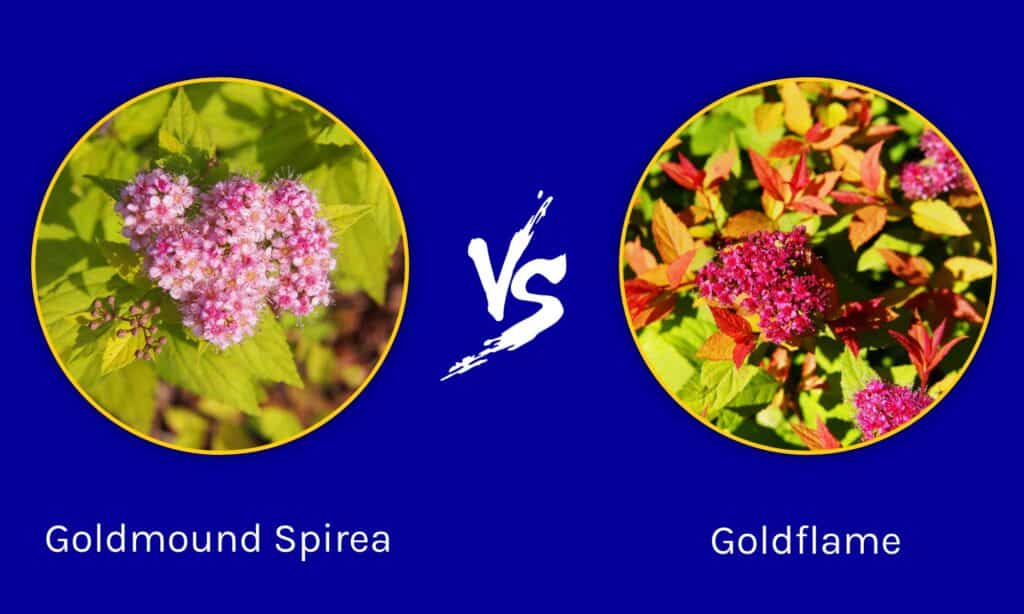Have you moved into a new home? Are you looking to bring more pollinators and add color to your front yard? Both the goldmound and goldflame spirea are great choices. These beautiful shrubs belong to the same family but are different spirea varieties. The differences are immense and very noticeable at first glance, however, they are grown in similar ways.
In this article, we will review how these two varieties are similar and different, as well as some interesting tips and tricks on growing these plants. In no time, you will be a goldmound and goldflame spirea expert.
Comparing Goldmound Spirea vs. Goldflame

Are you ready to discover the key differences and similarities between goldmound spirea vs. goldflame? To give you a hint, these are both spirea plants, just slightly different varieties. Keep reading to learn more about this wonderful plant!
Goldmound Spirea vs. Goldflame: Classification
Spireas are low-maintenance plants perfect for beginners who aren’t sure if they have a green thumb. They are also known as meadowsweets or steeplebushes. Technically, spirea is a genus with over 80 species belonging to the Rosaceae family. While they may not look like the common rose, they are closely related. Both the goldmound and goldflame spirea are S. japonica species. However, for the longest, the goldflame spirea was thought to be Spirea bumalda. They both originate in Eastern Asia, specifically Japan, Korea, and China.
Goldmound Spirea vs. Goldflame: Description

The goldflame spirea similarly grows as a compact shrub, but it can reach 4 to 5 feet tall and wide.
©Anna Gratys/Shutterstock.com
So, what do these beautiful shrubs look like? It might not surprise you to know that there are only slight differences. Actually, the goldmound spirea is a hybrid between S. japonica “Alpina” and S. japonica “Goldflame.” They both carry vibrant green leaves and bloom in the spring. Goldmound spirea plants are more compact and smaller than goldflame spirea. The leaves change in color frequently, usually to deep chartreuse. In spring, hundreds of little pink flower bloom from this shrub.
The goldflame spirea similarly grows as a compact shrub, but it can reach 4 to 5 feet tall and wide. This variety is also likelier to bloom far into summer than spring, but the flowers look the same as goldmound spirea plants. The leaves also change into a bronze-red color in the spring before changing to a dark yellow in the fall and winter.
Goldmound Spirea vs. Goldflame: Benefits
Are there benefits of owning spirea? Is the plant edible? Not only do these plants give your home a large pop of color and personality, but they were also used for years as a medicine. It was used to treat poison, heartburn, fevers, and inflammation. In some gardening circles, it is named the ‘aspirin’ of mother nature. It is also sometimes used in teas, giving users a calming effect.
Goldmound Spirea vs. Goldflame: Hardiness

Goldmound can withstand droughts, high humidity, and pollution, but it’s still best to use nutrient-rich and well-draining soil.
©Anna Gratys/Shutterstock.com
These low-maintenance plants are easily grown almost anywhere in the United States. They especially thrive in USDA zones 4-8. However, some tougher varieties can live in zones 3-9. Always check the instructions attached to a newly purchased goldmound spirea before planting it into the ground. They can withstand droughts, high humidity, and pollution, but it’s still best to use nutrient-rich and well-draining soil.
How to Grow Spirea Goldmound vs. Goldflame
So, have we convinced you to buy or plant your first goldmound or goldflame spirea? If yes, you should start by looking for a space in your garden where your plant gets just the right amount of sunlight. They grow well in containers as well as in the ground. If you plant them in the ground, dig a larger hole than the root ball. You can also grow from seed, but it does take longer. It’s more common to purchase spirea from a gardening center or nursery.
A good tip is to water the plant thoroughly after transplanting it to its new home. It takes some time for the roots to grow accustomed to the new soil and spot. If you see leaves wilting, don’t worry, this is normal! Too much water, though, can accidentally lead to root rot and kill your plant. It doesn’t hurt to add an extra layer of mulch on top of the soil. This helps retain moisture without causing an overflow. While these plants are resilient, you may not want to use something like sand, which can restrict the roots.
Other Common Spirea Varieties
Goldmound and Goldflame spirea are beautiful, but there are a lot more varieties that can leave you stunned. Spirea plants are known for their vibrant and quick-changing foliage. Listed below are other common spirea varieties you may want to invest in.
- Double Play Blue Kazoo
- Wedding Cake
- Glow Girl
- Double Play Candy Corn
- Double Play Doozie
Up Next:
10+ Perennial Flowers That Bloom From Spring To Fall
Jonquil vs Daffodil: Is There a Difference?
The photo featured at the top of this post is © Anna Gratys/Shutterstock.com
Sources
- North Carolina Extension Gardener Plant Toolbox, Available here: https://plants.ces.ncsu.edu/plants/spiraea-japonica-gold-mound/
Thank you for reading! Have some feedback for us? Contact the AZ Animals editorial team.






